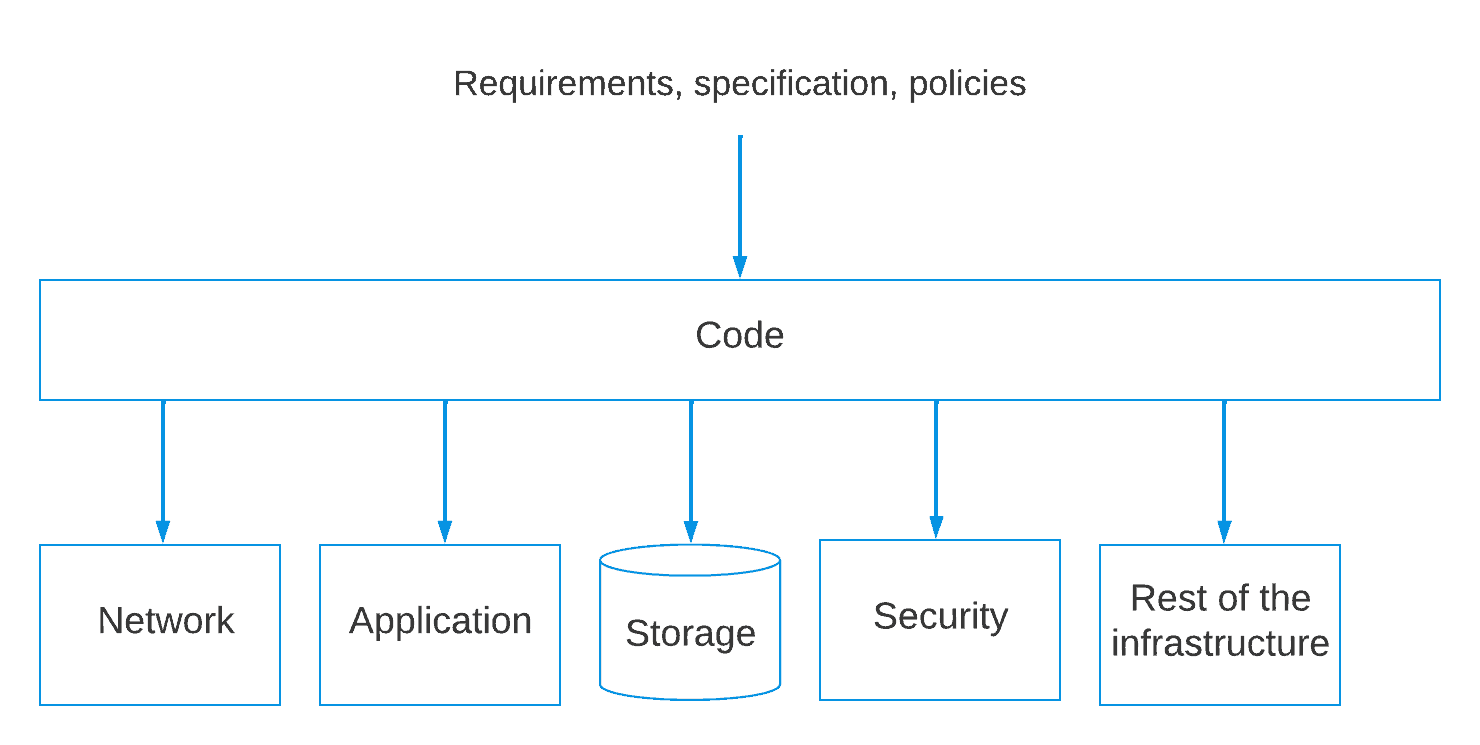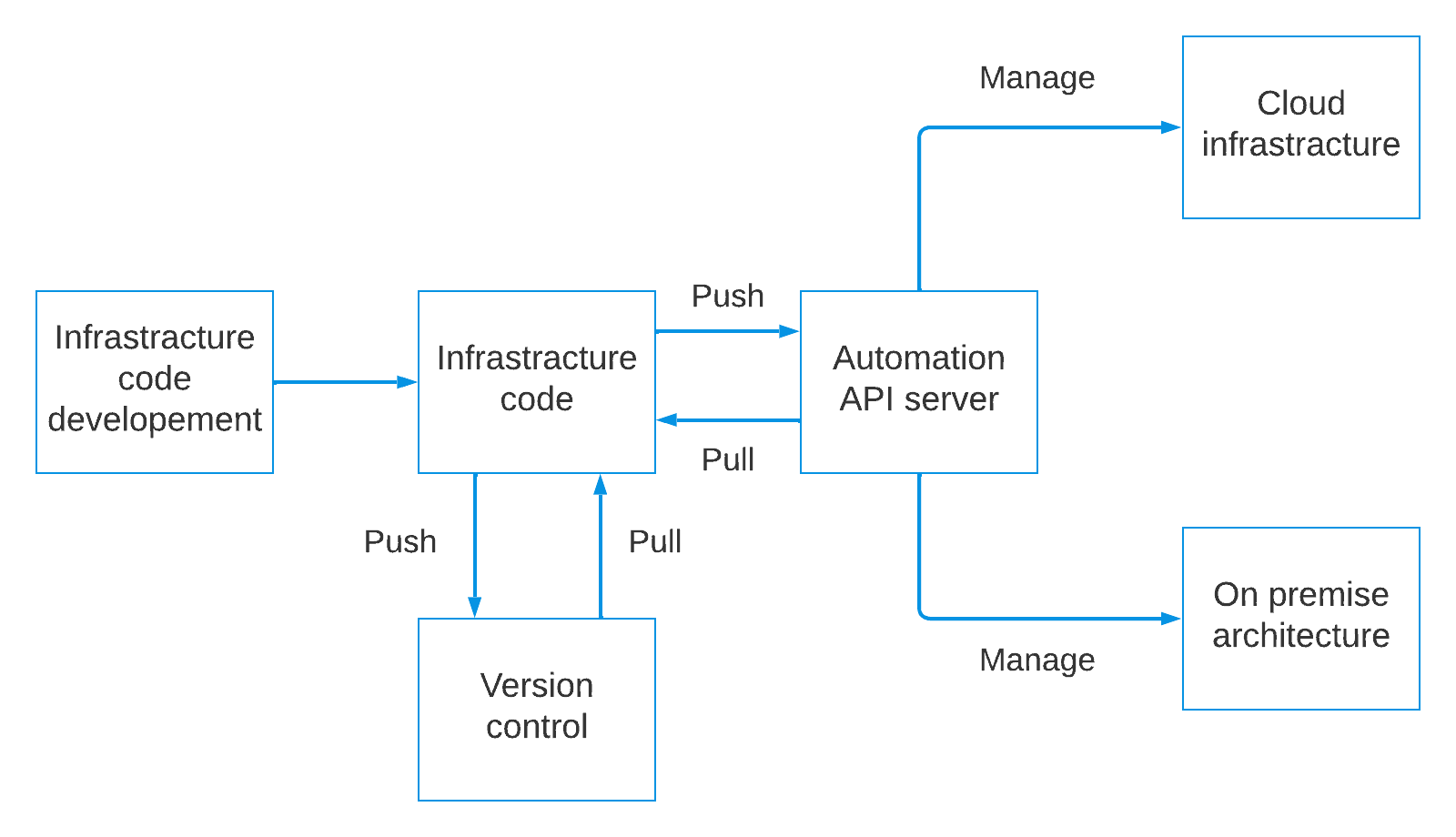Learn through the super-clean Baeldung Pro experience:
>> Membership and Baeldung Pro.
No ads, dark-mode and 6 months free of IntelliJ Idea Ultimate to start with.
Last updated: March 18, 2024
In recent years, Infrastructure as Code (IaC) has become an evolving trend in modern software development.
In this tutorial, we’ll describe IaC in detail, explore its fundamental principles and approaches, and understand why it’s so valuable for modern IT.
First, we can trace the roots of Infrastructure as Code to the rapidly changing landscape of software development and IT operations. With the advent of agile methodologies and DevOps practices, traditional infrastructure management methods showed limitations. Manually configuring servers and networks couldn’t keep pace with the dynamic requirements of modern applications.
So, at its core, Infrastructure as Code is about treating infrastructure: servers, networks, and databases, as something DevOps can control and manage through code:

Using IaC, we represent, configure, and maintain our infrastructure using code, scripts, or declarative language. That way, we avoid manual, error-prone, and time-consuming configuration.
We introduced Infrastructure as Code in the previous section and underscored its significance in modern IT environments. Now, let’s describe the key concepts that underpin IaC. Understanding these concepts is essential for grasping the foundations of IaC and comprehending its impact on infrastructure management.
At the heart of this approach is treating infrastructure as code. This concept fundamentally transforms infrastructure components’ definition, configuration, and management. Therefore, individuals represent and manipulate infrastructure using code or scripts instead of manually configuring servers or network devices.
In an IaC environment, the code becomes the single source of truth for infrastructure. This means that the code entirely defines the current state of the infrastructure, and any changes to the infrastructure must occur through code modifications. Thus, this approach eliminates configuration drift, where discrepancies between the desired and actual infrastructure configurations can occur over time.
There are two primary approaches to implementing IaC: declarative and imperative.
Declarative IaC defines the desired end state of the infrastructure without specifying the steps to achieve that state. This approach is often likened to describing what organizations want, and the chosen IaC tool determines how to make it happen.
Imperative IaC, on the other hand, involves specifying the exact steps or commands to reach the desired state. Thus, it’s akin to providing explicit instructions on achieving a specific configuration.
The choice between declarative and imperative approaches depends on factors like the complexity of the infrastructure, the specific IaC tool in use, and the preferences of the development and operations teams.
This section will explore practical steps and best practices for successfully adopting IaC, laying the foundation for efficient infrastructure management.
Firstly, before embarking on the IaC path, the organizations must comprehensively assess the infrastructure requirements. Then, they should examine the current infrastructure landscape and identify pain points, scalability needs, and areas where automation can bring improvements. This analysis serves as the foundation for shaping their IaC strategies.
Secondly, we must choose the appropriate IaC tools based on the technology stack. Community support, documentation, and integration capabilities must be considered. Tools like Terraform, Ansible, and AWS CloudFormation offer unique advantages and can significantly impact IaC’s success.
Furthermore, the organization must create version-controlled IaC templates or scripts that blueprint infrastructure components and configurations.
Maintaining version control ensures systematic tracking, testing, and documentation of changes, facilitating collaboration among team members.
The organization should promote collaboration among development, operations, and infrastructure teams. It should define clear roles and responsibilities for IaC tasks to align everyone toward the common goal of efficient infrastructure management. A collaborative approach is essential for success.
Then, we need to integrate CI/CD pipelines to automate the deployment of IaC templates. These pipelines streamline testing and deployment processes, reducing the risk of errors and ensuring template compliance. That way, we get a more reliable infrastructure.
Finally, we should monitor the organization’s infrastructure for deviations from defined templates. Regularly updating templates to adapt to changing requirements ensures a responsive and adaptable infrastructure. Proactive maintenance minimizes disruptions and enhances overall operational efficiency.
Here’s the workflow of the IaC development process:

The steps are:
IaC offers numerous benefits but also poses particular challenges.
Firstly, one of the standout advantages of IaC is efficiency. With IaC, infrastructure configurations are codified, allowing for rapid and automated provisioning. This means that instead of manually configuring servers, networks, or databases, we can define the infrastructure as code and let automation tools handle the rest. This speeds up deployments, reduces human error, and enhances overall productivity.
Secondly, IaC brings consistency to infrastructure management. Since configurations are defined in code, they are consistent across environments. Whether deploying to development, testing, or production, we ensure that the configurations remain the same, reducing the chances of discrepancies and enhancing reliability.
Moreover, IaC promotes version control. Just like application code, infrastructure code can be stored in repositories, allowing for easy tracking of changes. Teams can roll back to previous configurations if needed, improving traceability and auditing.
Furthermore, IaC supports scalability and flexibility. As organizations grow, they can easily replicate infrastructure components by reusing code. This flexibility ensures that infrastructure can expand to accommodate increasing demands.
Lastly, IaC lets us rebuild the entire infrastructure quickly in case of an unexpected failure. This means less downtime and more peace of mind for the team.
However, it’s essential to consider the challenges that come with IaC.
First and foremost, the initial adoption of IaC can be complex. Teams need to become proficient in the tools and practices associated with IaC, which may require training and skill development.
Secondly, maintaining IaC can become cumbersome if not done correctly. As our infrastructure code grows, it must be well-organized to remain manageable. Otherwise, it can become as intricate as the infrastructure it manages.
Moreover, there might be resistance to change within organizations. Teams accustomed to traditional infrastructure management methods may be reluctant to embrace IaC. A cultural shift may be required to leverage the benefits fully.
Furthermore, while IaC enhances efficiency, an erroneous change in the code could lead to the rapid propagation of mistakes across the infrastructure, necessitating thorough testing and safeguards.
Let’s summarize the advantages and disadvantages of IaC:
| Benefits | Drawbacks |
|---|---|
| IaC brings consistency to infrastructure management | Maintaining IaC can be a burden if not done correctly |
| IaC provides scalability and flexibility | The initial adoption of IaC can be complex |
| IaC promotes version control | An error in the code can cause propagation of mistakes across the infrastructure |
| IaC enhances efficiency | Teams can need cultural shift to adjust to IaC |
| IaC can become a single point of truth for the infrastructure | IaC is no universal solution and may not be the best choice for every organization |
Different tools and practices may be better suited to specific use cases. Therefore, before choosing IaC, organizations must consider many factors before choosing the right strategy.
In this article, we described Infrastructure as a Code (IaC) in detail. IaC offers efficiency, consistency, and agility but demands careful consideration.
Efficiency and scalability make IaC compelling, but complexity, maintenance, and cultural shifts can be time and resource-consuming.
Infrastructure as a Code isn’t a universal solution for every project or organization.